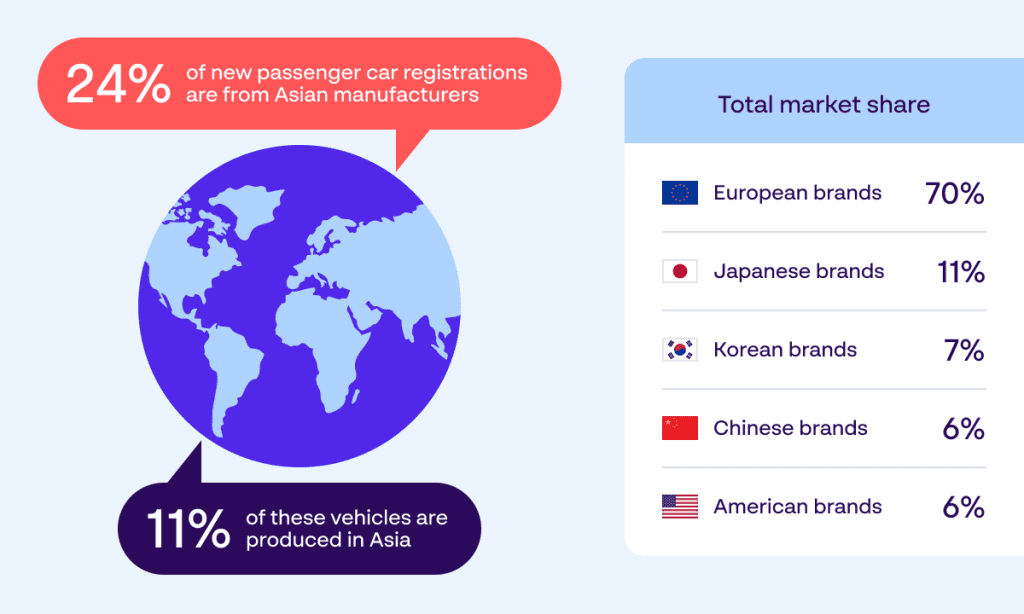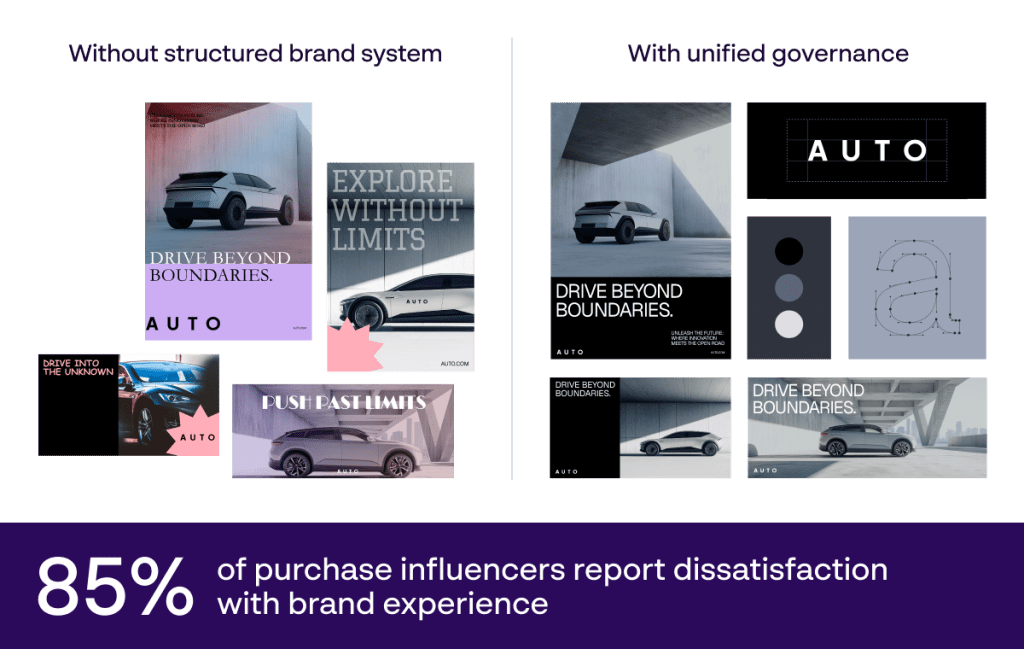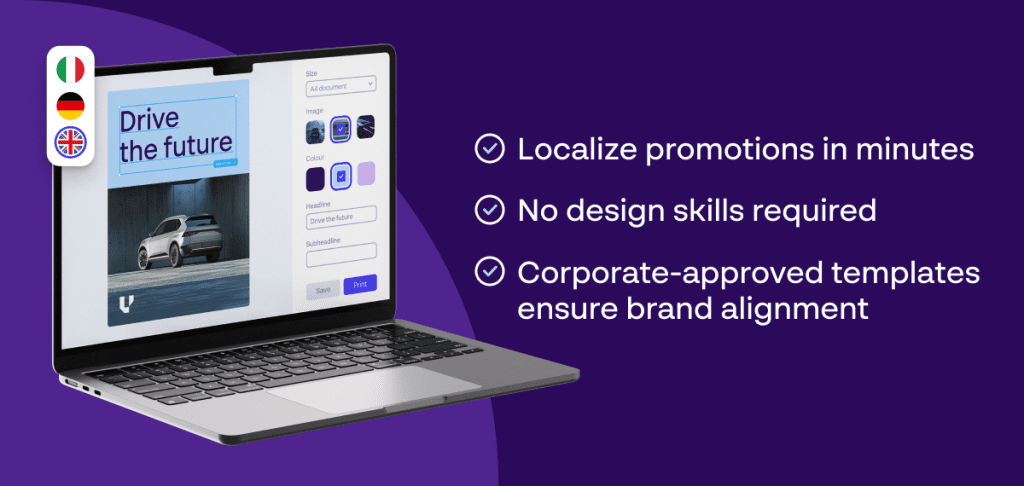In today’s competitive automotive industry, standing out is more challenging than ever. The rise of cost-effective foreign manufacturers and global automotive giants puts European brands under pressure. For marketing directors and brand managers, adapting while maintaining brand consistency is crucial.
Staying recognizable in a shifting landscape
1. Rising competition from foreign brands
Asian manufacturers now account for 24% of new passenger car registrations in Europe, with 11% of these vehicles made in Asia. Their aggressive marketing saturates media, making it harder for local brands to compete. Without a centralized brand strategy, European brands risk being overshadowed in consumer perception.
Additionally, automotive brands in transformation to e-mobility face a market that isn’t fully keeping up, largely due to economic decline and shifting consumer preferences. The increased influence of U.S. and East Asian brands further challenges German automakers’ ability to maintain dominance in key global markets.
Foreign Brands Gain Ground in Europe

2. Budgetary pressures limiting marketing impact
Economic uncertainties have tightened marketing budgets across the DACH region. In Germany, advertising spending has fluctuated, reaching €2.32 billion in recent years. Additionally, only 12% of marketing leaders believe their teams are structured to meet revenue goals, and just 7% feel they have the right skills to execute effective campaigns. With fewer resources, maintaining a strong brand presence requires smarter, more efficient marketing solutions.
Moreover, as budgets tighten, brands struggle to allocate funds to localizing content while maintaining consistency, which can create inconsistencies in branding across dealership networks and sub-brands.
Marketing impact in tight times

3. Dominance of global conglomerates
Mergers and alliances allow major players to pool resources, making it difficult for smaller brands to compete. Furthermore, 85% of global purchase influencers have reported dissatisfaction with at least one aspect of a winning vendor’s experience, emphasizing the need for a clear and consistent brand identity that resonates with consumers and business buyers alike.
At the same time, automotive brands in the DACH region face the challenge of managing multiple sub-brands while ensuring unified brand representation. Without a structured system, regional inconsistencies arise, weakening consumer trust and recognition.
Amid these challenges, European brands must focus on speed, efficiency, and consistency to remain visible and strengthen consumer connections.
Consistency Builds Recognition

The role of local dealerships in brand success
One of the most critical elements of brand success in the automotive industry is the dealership network. While corporate teams establish brand identity and global messaging, dealerships are the frontline representatives of the brand. They interact directly with customers, respond to regional market demands, and drive local sales.
However, without a structured brand governance system, dealerships often face challenges such as:
- Inconsistent marketing execution – Local teams create off-brand content, leading to a diluted customer experience.
- Slow response to market trends – Relying on external agencies slows down content creation, delaying campaigns and promotions.
- Lack of visibility over brand compliance – Corporate teams struggle to ensure marketing materials adhere to brand guidelines.
To succeed, automotive brands must strike the right balance between centralized control and dealership-level flexibility.
Leveraging templated content creation
A structured and scalable content creation process offers a streamlined solution for automotive brands, ensuring consistency, efficiency, and adaptability across all marketing efforts.
1. Faster creation = faster recognition
Brand consistency builds trust and strengthens consumer bonds. With on-brand content creation, marketing teams can quickly produce and deploy content using pre‑approved templates, ensuring all marketing materials meet brand guidelines while reducing inefficiencies caused by disconnected regional strategies.
Dealerships can access corporate-approved templates that allow them to customize messaging, promotions, and campaigns while maintaining a strong, unified brand identity.
2. Increased output without extra costs
Scaling content creation without additional resources is crucial in a cost-conscious environment. Since only 7% of marketing leaders feel confident in their teams’ skills, an intuitive templated system enhances efficiency by enabling all stakeholders—from corporate marketing to regional dealerships—to contribute to brand communication without specialist design skills.
With built-in approval workflows, content can move seamlessly from production to publication, ensuring brand compliance at every step and reducing costly design bottlenecks.
Scalable Creativity Without the Extra Cost

3. Localized content with regional consistency
The European market’s cultural diversity demands tailored content. A on-brand content creation solution allows local teams to adapt marketing assets while maintaining a globally aligned brand identity. This ensures:
- Faster adaptation of marketing materials to suit local market needs.
- Compliance with brand guidelines across all regional activations.
- A seamless blend of corporate control and dealer-level flexibility.
By leveraging a Digital Asset Management (DAM) system, automotive brands can:
- Centralize all marketing assets, ensuring easy access to up-to-date, approved content.
- Implement user permissions that tailor access for dealerships, distributors, and corporate teams.
- Maintain a consistent brand identity even as sub-brands and markets evolve.
Building brand trust through digital transformation
A strong and adaptable branding strategy is crucial for automotive brands to remain competitive in an evolving market. To successfully balance global brand consistency with local market demands, companies must implement structured digital asset management and on-brand content creation solutions. Here’s how:
- Adapting to shifting consumer demands As consumer preferences evolve and economic conditions fluctuate, brands need to respond quickly. A structured content system allows local teams to launch localized promotions and seasonal campaigns instantly, ensuring they remain relevant and responsive without waiting for lengthy approvals from corporate headquarters.
- Enhancing dealer engagement Local dealerships are the face of the brand, and they need tools to execute marketing effectively. Providing an on-brand content creation system empowers dealers to customize materials while maintaining corporate‑defined standards. This creates a sense of ownership and ensures that local marketing efforts align with the broader brand strategy.
- Ensuring effortless brand compliance Without proper oversight, brand inconsistencies can arise across different regions and dealership networks. A centralized digital asset management (DAM) system enables corporate teams to control branding elements, ensuring only approved, up-to-date content is used. Automated compliance checks and streamlined approval processes prevent off‑brand messaging and safeguard brand integrity.
A competitive edge for the automotive industry
With Papirfly’s integrated suite, brands can transform their marketing operations to compete more effectively:
- On-brand content creation at scale – Ensuring speed and efficiency in marketing asset production across all markets.
- Eliminating marketing inefficiencies – Reducing time spent searching for assets and recreating content that already exists.
- Strengthening brand consistency – Unifying brand representation across all sub‑brands and dealership networks.
Drive your brand forward with Papirfly
In a dynamic market, speed and consistency are essential. Papirfly’s On-brand Content Creation solution helps brands adapt, strengthen their presence, and engage audiences effectively.
Ready to take the lead?
Discover how Papirfly’s On-brand Content Creation solution can enhance your brand’s marketing and visibility. Visit our automotive solutions page to learn more.


